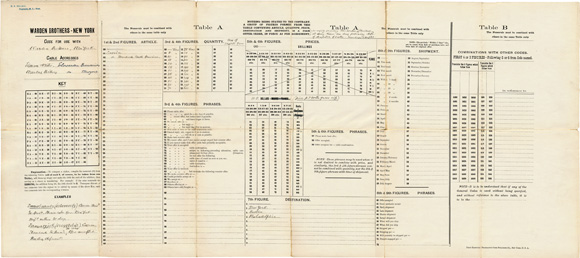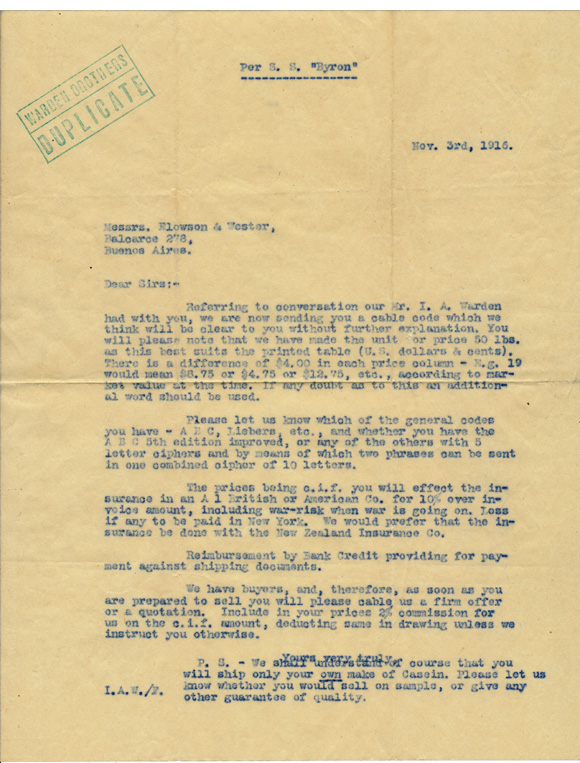Code for use with Warden Brothers, New York
Elowson & Wester, Elowarden – Buenosaires
Warden Brothers do. Newyork
ca 1916
Printed one side on sheet that unfolds to 36 inches (91cm) wide, 16 inches (40cm) high
The magnified image was scanned, one folded section at a time, and digitally reassembled.
private collection
This code provides a one-page panoptical view of anything that might want to be communicated about casein with Argentinean trading partners. The cable address Elowarden was the same for the two parties in New York and Buenos Aries, respectively. This is what E L Bentley described as a chain or sectional cipher code. You assemble a 10-figure message one or two figures at a time, step by step through the facets/aspects of meaning, then convert to pronounceable CVCV ciphers. One proceeds through Tables A and B as follows:
Table A
1st and 2nd figures. Article.
3rd and 4th figures. Quantity, or
3rd and 4th figures. Phrases.
5th and 6th figures. Prices.
7th figure. Destination.
8th and 9th figures. Shipment, or
8th and 9th figures. Phrases.
The tenth figure is the unit
of the sum of the first nine figures, and is used as a check.
Table B is for combinations with other codes (e.g., ABC, Liebers).
Two examples are given :
DAMOBANADY (026000108/7) Casein Stand.d So. Amer.n. Please cable offer New York ship.t within 30 days.
DAMASYJATI (020998064/8) Casein Standard So. Amer.n. 50 Tons — Offer accepted – Hasten shipment.
Note the partical
prices for the 5th and 6th figures: you would translate on the basis of most likely price, according to market value at the time,
as the accompanying letter of introduction/explanation puts it. The letter continues: If any doubt as to this an additional word should be used.
Elowson and Wester was a major Argentinean dairy firm that produced casein, a kind of plastic. It was used to make buttons, pens and other items that could take advantage of its qualities, including receptivity to coloring agents. It was also used in matches as a waterproofing agent. Casein had a bigger use in Europe than in the U.S. From online sources, one encounters the suggestion that U.S. traders got caught in contracts they wanted out of, and lost. Maybe Warden Brothers was one of them.
Casein is a byproduct of producing cream: leaves skim milk, which is then processed (with the addition of rennet, an enzyme) to yield this substance, that then is precipitated out and powdered. The Caseino provides much technical and historical information. The firm Elowson y Wester (and later contractual issues with American buyers) is discussed here (in Spanish, an official history of the dairy industry in Argentina).
The letter at left is dated November 3, 1916, which I take as a rough indication of the date of the code.

